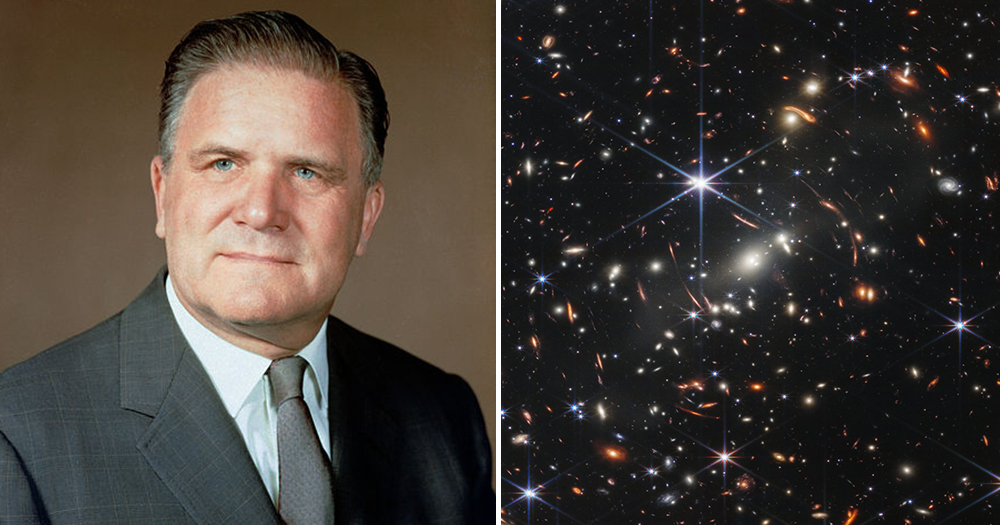The past few days have seen the internet delighting in the gorgeous images NASA released July 12, the first seen from the James Webb Space Telescope. For some, though, the incredible discoveries the telescope can make are tainted by its name, thanks to the complicity of James Webb in government homophobia.
Webb directed NASA during the 1960’s, at the peak of the Space Race, and oversaw impressive advances in the US’ exploration of space such as the Apollo program. But in both this position and his role as Undersecretary in the US State Department, held from 1949 to 1952, Webb acted in management roles at a time of aggressive state homophobia, when the federal government actively sought to rid itself of anyone even suspected of homosexuality.
Many call this purge the Lavender Scare, as it occurred hand in hand with the Red Scare, when many Americans, especially in government or federal agencies, were investigated and fired for being communists or suspected communist party members. Amid the intense Cold War atmosphere of the 1950’s and ’60s, the federal government placed immense importance on national security and the safety of government secrets.
In 1950, a Senate subcommittee published a report and resolution on “Employment of Homosexuals and Other Sex Perverts in Government.” The report states, “In the opinion of this subcommittee homosexuals and other sex perverts are not proper persons to be employed in Government for two reasons; first, they are generally unsuitable, and second, they constitute security risks.” The subcommittee held the belief that LGBTQ+ people were “moral perverts” and therefore unwise to have in government work, and that they could easily be blackmailed due to their homosexuality, putting classified information at risk.
This policy of keeping LGBTQ+ people out of government became official policy with an executive order from President Dwight Eisenhower in 1953, but queer people were already being investigated and fired beforehand, including during James Webb’s tenure as Undersecretary of State. A Slate article discussed Webb’s involvement in this state-sanctioned homophobia, reporting that “Webb was actively involved in these firings, which involved 425 people.”
An astronomer at Columbia University additionally found evidence of Webb’s role as a “facilitator of homophobic policy discussions with members of the Senate,” including passing along homophobic materials to members of the government, according to an opinion piece in Scientific American calling for the telescope to be renamed.
“As someone in management, Webb bore responsibility for policies enacted under his leadership, including homophobic ones that were in place when he became NASA administrator,” the article reads. The authors write that admittedly, everyone in the NASA administration during the Lavender Scare was complicit in the widespread homophobia, but that this doesn’t make it acceptable to name the fantastic new telescope in question after Webb.
The marginalisation of LGBTQ+ people in physics and astrophysics persists to this day, they argue, meaning that while Webb may have contributed to the exploration of space in some respects, the problematic aspects of his legacy also remain and must be taken into account.
The importance of the telescope make this issue especially important to many, as it is not a small or niche project. The telescope took more than a decade and nine billion dollars over original predictions to build, and can do incredible things like finding new galaxies and planets that could support life. “The name of such an important mission, which promises to live in the popular and scientific psyche for decades, should be a reflection of our highest values” the Scientific American article argues.
Scholars and activists have been calling for the telescope to be renamed for years, as planning for it began in the 1990’s. A petition demanding this change currently has over 1700 signatures from people invested in space exploration in some form.
“Those who would excuse Webb’s failure of leadership cannot simultaneously award him credit for his management of Apollo. Leaders are responsible not only for the actions of those they lead, but the climate they create within their spheres of influence,” the petition reads in part.
It echoes calls by the opinion piece from Scientific American for the telescope to be renamed after Harriet Tubman, since she used the stars to guide slaves to freedom, and better reflects the morals and values people wish to see immortalised.
However, at least as of fall 2021, NASA had no plans to change the telescope’s name.
The space agency said it had performed an investigation on Webb’s role in government discrimination, but that they will not be making a change. “We have found no evidence at this time that warrants changing the name of the James Webb Space Telescope,” NASA administrator Bill Nelson told NPR in September.
© 2022 GCN (Gay Community News). All rights reserved.
Support GCN
GCN is a free, vital resource for Ireland’s LGBTQ+ community since 1988.
GCN is a trading name of National LGBT Federation CLG, a registered charity - Charity Number: 20034580.
GCN relies on the generous support of the community and allies to sustain the crucial work that we do. Producing GCN is costly, and, in an industry which has been hugely impacted by rising costs, we need your support to help sustain and grow this vital resource.
Supporting GCN for as little as €1.99 per month will help us continue our work as Ireland’s free, independent LGBTQ+ media.

comments. Please sign in to comment.